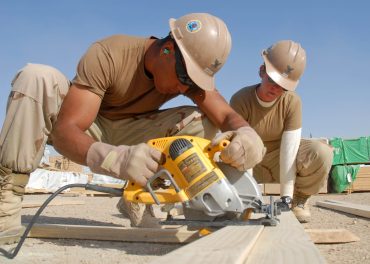
John Bleasby
Is legalized marijuana coming to your job site?
Canadian ContractorContractors need more than just “toke’n” policies
With legalized pot only seven months away, the big question on contractors’ mind might be this: “Will my guys be allowed to light up a joint whenever they please?” The short answer is, “No; no more than they can drink vodka on the site”. If that’s all you want to know, you can stop reading now. However, the issue is far more complex than that. If you want to prepare your company for the complex issues surrounding the permitted use of marijuana or any other drug, scroll down!

Can workers light up a joint just because it’s legal? Short answer: NO!
“Hi! How are you?” becomes, “How high are you?”
Marijuana is already legal in Canada, the result of several legislative changes over recent years concerning medical prescriptions. In the meantime, illegal recreational use of marijuana has steadily increased, particularly among younger people. A 2013 study indicated that 25 per cent of Canadians between 15 and 24 years were using marijuana. The numbers are expected to grow significantly once marijuana is legalized on July 1, 2018. So be aware! More members of your workforce may consider smoking up at some point during their work week.
“But the doctor said I could!”
Medical marijuana use is also expected to grow over the next decade, both as a cigarette and in products like baked goods and oils. That’s where it becomes a complex safety and human rights issue for employers, contractors in particular; Under provincial Humans Rights Codes, workers with disabilities who are prescribed marijuana cannot be subject to discrimination.
Yet at the same time, occupational health and safety legislation also requires employers to take reasonable precautions to protect all their workers. Throw in legislation and local bylaws that promote a smoke-free work environment, and the importance for employers to have policies in place that deal with marijuana use on the job site becomes clear. Your workers are using heavy machinery, tools, and often work at heights. Since general contractors are responsible for what occurs on their sites, it follows that those policies should extend beyond their own employees to the sub-trades brought onboard, especially if those subs don’t have policies of their own.
“Employees do not have a right to be impaired at work”
Those words were repeated several times by Stephanie DiFrancesco of Toronto-based law firm McMillan LLP at a seminar during the recent Building Show in Toronto. Furthermore, DiFrancesco explained that employers do not have to tolerate an employee who is impaired due to the use of drugs or alcohol, whether legal and recreational or medical and prescribed. However, site supervisors need to focus on safety, she said, not morality and productivity.

Safety is paramount, for not just marijuana on the job site, but any other prescription drug. Safety means the safety of others too
Ask yourself about the current culture within your company. For example, do you turn a blind eye to employees having a casual beer during lunch on site, at the curbside, or in the privacy of their cars? With legalized marijuana on the horizon, you probably don’t want workers regarding recreational weed as acceptable behavior during working hours either, particularly if there’s any risk of impairment. Even under a prescription, marijuana use must be regarded as a safety issue needing assessment.
Prepare yourself with safety policies
Maybe it’s time you put well-considered drug and alcohol policies in place that address the dual concerns of site safety and human rights, and explain them to everyone. Given the increasing use of marijuana under prescription, coupled with its soon-to-be-legal recreational status, those policies should define the terms ‘impairment’, intoxication’ and ‘under the influence’ precisely enough to capture prescription drugs including medical marijuana while on site. Acceptable boundaries regarding both alcohol and drugs, along with self-reporting protocols should be outlined, plus a progressive discipline policy for violations or any incidents of illegal use or impairment. It will save you lots of trouble down the road should an individual claim discrimination.
The curious incident of the company vehicle, a moose, and a joint
DiFrancesco cited a case where an employee struck a moose with a company vehicle (Canada, eh?). Marijuana was found in the vehicle. The employee claimed a prescription due to cancer, although he had never informed his employer or provided any supporting documentation. The employee was fired, but shot back with a discrimination claim. Given the employer had previously established a zero-tolerance drug and alcohol policy, and the fact that the employee could not provide evidence of a prescription, the dismissal was upheld.
The complications of medical marijuana
While no legislation enshrines a worker’s right to use recreational drugs or alcohol on the job site, human rights legislation does protect those with disabilities who need prescriptions. Workers with chronic pain, for example, are permitted to use prescribed drugs to deal with their disability. However, just as there is an obligation on the employer to accommodate employees with bona fide medical conditions and medication prescriptions, the employee has obligations as well. They must, for example, disclose their disability to the employer, answer questions regarding how it could restrict their work effectiveness, give details concerning their prescriptions, and be agreeable to cooperating with their employer when developing an accommodation strategy that will permit them to continue working on the site.
In the case of an employee assigned to a safety-sensitive area of work who has been prescribed marijuana, the employer has the right to request medical documentation and to reassign the worker to another area of work if an assessment reveals safety to be in jeopardy. However, employers must be careful that accommodating the needs of an individual does not impose hardship or risk on co-workers; they in turn could refuse to work if they regard the site to be unsafe due to marijuana use.
All this must be approached in a reasonable manner — obtaining medical information, assessing the safety sensitivity of the role, and exploring options for reassignment including modifying the work to be performed or the degree of co-worker interaction. Records must be kept with confidentiality. Without fair and proper assessment, discussion with effected workers, and reasonable attempts at accommodation, the employer could risk a charge of discrimination.
Follow John on Instagram and on Twitter for notifications about his latest posts

![]()
Got feedback? Make your opinion count by using the comment section below,
or by sending John an email:
JBleasby@canadiancontractor.ca

Leave a Reply